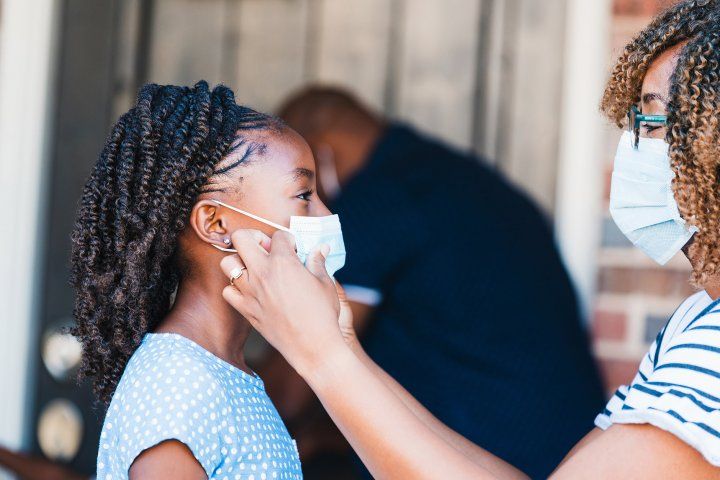To Stop COVID-19 Spread in Schools, Start with Local Data and Do the Math
Infection in General Population Mirrors Pediatric Prevalence, UCSF Study Shows

As schools across the country continue to wrestle with configurations of online and in-classroom learning, a new study from UCSF Benioff Children’s Hospitals shows that public data and a simple equation may be all that is required to estimate the number of infected students who might be in a classroom. The result may help school districts make tough decisions on whether it is safe for students to return to the classroom, and in what numbers.
UCSF has created an interactive tool to allow users to estimate the likelihood that a child in any county of the United States may have asymptomatic COVID-19. This tool may be used for estimating the risks associated with classrooms of different sizes.
In the study, which publishes in JAMA Pediatrics on Aug. 25, 2020, researchers compared the prevalence of SARS-CoV-2, the virus that causes COVID-19, among asymptomatic children and found that it roughly reflected the number of confirmed local cases in the general population.
The researchers traced SARS-CoV-2 testing results for more than 33,000 children from 28 hospitals in 25 regions nationwide, who had been routinely tested prior to undergoing surgical procedures or medical care unrelated to the virus. Some 250 patients were found to have asymptomatic COVID, the most common manifestation of the virus in children. These patients represented 0.65 percent of all pediatric patients tested, or one in 155; ranging from 0 percent to 2.2 percent depending on the region.
Linear Relationship Consistent Across All Regions
The researchers then compared the data for each hospital with weekly confirmed cases in the hospital’s catchment area, available on Johns Hopkins Coronavirus Research Center. “We found that there was a linear relationship between the prevalence of SARS-CoV-2 infections in the asymptomatic pediatric population and cases in the general population, and that this relationship was consistent across all regions,” said senior author Dylan K. Chan, MD, PhD, from the UCSF Division of Pediatric Otolaryngology. “A region that had twice as high a rate of COVID in the general population compared to another region, had twice as high a rate of asymptomatic pediatric infections.”
The researchers reversed this operation, calculating the asymptomatic pediatric prevalence by using the public data, together with an equation they had developed (asymptomatic pediatric prevalence (%) = 1.07 x the weekly incidence (per 1000 general population) + 0.23). “We plugged a different, later set of public data into our equation and generated ‘estimated’ prevalence numbers,” said Chan. “When we compared them to the updated actual prevalence numbers that we then obtained for an additional 15,000 asymptomatic children, we found our estimates were pretty accurate.”
As an example, the prevalence of asymptomatic COVID among the patients tested at UCSF Benioff Children’s Hospital San Francisco – one of the 28 hospitals in the study – was 0.64 percent in June. The catchment area for the hospital covers the cities of San Francisco, Oakland and San Jose and surrounding 14 counties. The researchers used weekly confirmed cases in public data from this catchment area over the same time period, applied their equation and reached 0.79 percent, which was within the statistical error of the actual measurement.
Chan asserts that this formula can be used to calculate the risk that an infected asymptomatic child is in a classroom. “Widespread testing is impractical since you would need to test thousands of kids in a community to get an approximation of asymptomatic infection,” Chan said, noting that data from a city population of 1,000 with a single case would preclude a precise estimation.
Percent Chance of One Child with SARS-CoV-2 in a Classroom in Metropolitan Areas
Risk in S.F. Schools Reaches 30 Percent
Based on public data for the first half of August, the estimated asymptomatic pediatric prevalence for San Francisco would be 1.1 percent, according to the researchers. In a hybrid-model classroom with 11 students, even if all students had been screened for symptoms of COVID-19 and were asymptomatic, there would be an 11 percent chance of at least one infected asymptomatic student. In a regular lower-grade classroom with 22 students, that risk would be elevated to 22 percent, and with a regular upper-grade class with 33 students, the risk would reach 30 percent.
In Merced County, in California’s Central Valley, the estimated pediatric prevalence is 4.6 percent, resulting in a 40 percent chance of having at least one infected student in a hybrid-model classroom with 11 students, 64 percent in a 22-student classroom and 79 percent in a 33-student classroom. In contrast, the estimated pediatric prevalence in New York is 0.7 percent, with the chance of having at least one infected student in the classroom pegged at 8 percent, 15 percent and 21 percent respectively.
While the risk of an asymptomatic child infecting another child remains unknown, the model may represent the best means of estimating the percentage of children with active but asymptomatic COVID using continuously updated public data, said Chan. Because the team developed the model using 25 different regions spanning the country, the researchers believe their findings should be generalizable to most communities nationwide.
Percent Chance of One Child with SARS-CoV-2 in a Classroom in California Counties
Authors: Senior author is Dylan Chan, MD, PhD. First author is Ana Marija Sola, a medical student at UCSF. Co-authors are Abel David, MD; Kristina Rosbe, MD; Atsuko Baba, MD; and Lynn Ramirez-Avila, MD, all of UCSF.
UCSF Benioff Children’s Hospitals are two leading Bay Area children’s hospitals with longstanding commitments to public service. UCSF Benioff Children’s Hospital San Francisco and UCSF Benioff Children’s Hospital Oakland both have leading pediatric residency programs, unique pediatric subspecialty fellowship programs, a research base for the next generation of discoveries, and expertise in pediatric clinical care, public policy and patient advocacy.